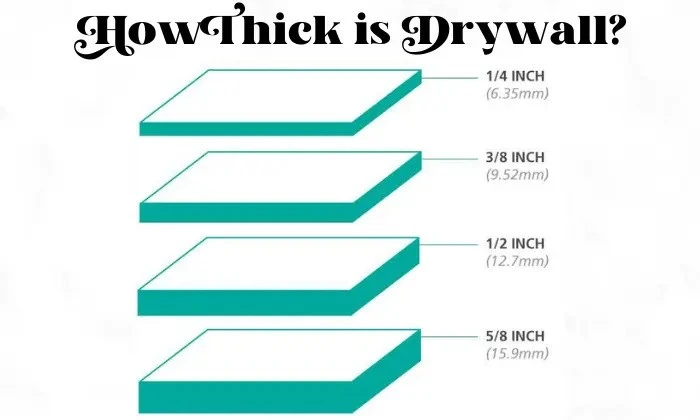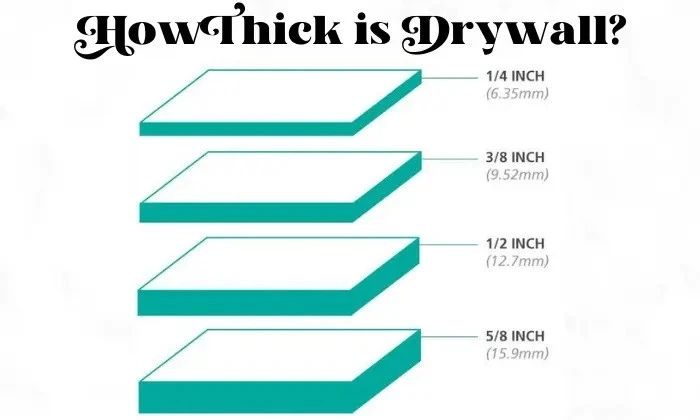Drywall, also known as plasterboard or gypsum board, is a crucial material used in building interior walls and ceilings. It provides a smooth surface for painting or finishing and offers soundproofing and fire resistance. One key aspect of drywall is its thickness, which varies based on the application. This blog post explores the different drywall thicknesses, including the less common 1-inch drywall, and discusses the suitable types for residential, commercial, and bathroom uses.
Types of Drywall Thickness
Drywall comes in several standard thicknesses, each suited for specific applications:
1/4-Inch Drywall
- Application: Mainly used for curved surfaces or as a second layer over existing walls.
- Advantages: Lightweight and flexible, making it perfect for creating curves.
- Disadvantages: Not suitable for primary structural walls due to its fragility.
3/8-Inch Drywall
- Application: Commonly used in repair work and for covering existing surfaces.
- Advantages: Slightly more robust than 1/4-inch drywall but still relatively thin.
- Disadvantages: Not recommended for new construction as a primary wall surface.
1/2-Inch Drywall
- Application: The most common thickness used in residential construction for walls and ceilings.
- Advantages: Provides a good balance between strength and weight.
- Disadvantages: May require additional support in ceilings with wider joist spacing.
5/8-Inch Drywall
- Application: Frequently used in commercial buildings and areas requiring enhanced fire resistance.
- Advantages: Offers better soundproofing and fire resistance compared to thinner drywall.
- Disadvantages: Heavier and more challenging to install, requiring stronger framing.
1-Inch Drywall
- Application: Less common, typically used in specific fire-rated assemblies or for soundproofing.
- Advantages: Exceptional fire resistance and soundproofing capabilities.
- Disadvantages: Very heavy and difficult to install, often requiring special handling and support.
Drywall for Residential Applications
In residential construction, 1/2-inch drywall is the standard choice for most interior walls and ceilings. This thickness provides sufficient strength and durability for typical household use. However, certain areas within a home might benefit from different thicknesses:
Living Areas and Bedrooms
- Recommended Thickness: 1/2-inch drywall
- Reasoning: Offers a smooth, paintable surface while being sturdy enough for most applications. It also provides adequate soundproofing between rooms.
Kitchens and Utility Rooms
- Recommended Thickness: 1/2-inch drywall
- Reasoning: These areas might see more wear and tear, but 1/2-inch drywall is typically sufficient. In some cases, moisture-resistant drywall may be used for added protection.
Ceilings
- Recommended Thickness: 1/2-inch or 5/8-inch drywall
- Reasoning: Ceilings with wider joist spacing (over 24 inches) may benefit from the added rigidity of 5/8-inch drywall to prevent sagging.
Drywall for Commercial Applications
Commercial buildings often have different requirements compared to residential structures. Here, the choice of drywall thickness is influenced by factors such as fire codes, soundproofing needs, and structural demands:
Office Spaces
- Recommended Thickness: 5/8-inch drywall
- Reasoning: Enhanced soundproofing and fire resistance are critical in commercial settings, making 5/8-inch drywall the preferred choice.
Retail Stores
- Recommended Thickness: 5/8-inch drywall
- Reasoning: Provides better durability and fire resistance, crucial for spaces with high foot traffic and safety regulations.
Industrial and Warehouse Spaces
- Recommended Thickness: 5/8-inch or thicker, including specialty fire-rated drywall
- Reasoning: These areas may require additional fire protection and soundproofing, especially if they contain flammable materials or machinery.
Drywall for Bathroom Use
Bathrooms present unique challenges due to high moisture levels. Standard drywall is not suitable for these environments, as it can absorb water and promote mold growth. Instead, moisture-resistant or mold-resistant drywall should be used:
Moisture-Resistant Drywall (Greenboard)
- Application: Commonly used in bathrooms, particularly on walls and ceilings.
- Advantages: Designed to resist moisture better than standard drywall.
- Disadvantages: Not completely waterproof, so it should not be used in areas with direct water exposure, like shower surrounds.
Mold-Resistant Drywall (Purpleboard)
- Application: Ideal for bathrooms and other damp areas.
- Advantages: Offers additional protection against mold growth.
- Disadvantages: Slightly more expensive than standard moisture-resistant drywall but worth the investment for mold-prone areas.
Cement Board
Board
- Application: Used behind tiles in showers and tub surrounds.
- Advantages: Completely waterproof and highly durable, providing a solid base for tile installation.
- Disadvantages: Heavier and more challenging to work with compared to standard drywall.
Conclusion
Choosing the right thickness of drywall is crucial for ensuring the durability, safety, and functionality of your walls and ceilings. For most residential applications, 1/2-inch drywall is sufficient, while commercial buildings often require the enhanced properties of 5/8-inch drywall. Bathrooms and other high-moisture areas demand specialized moisture-resistant or mold-resistant drywall to prevent water damage and mold growth. Understanding the specific needs of each space will help you make the best decision for your construction or renovation project.
In summary, drywall thickness plays a significant role in the performance of your walls and ceilings. By selecting the appropriate type and thickness, you can ensure that your space is not only aesthetically pleasing but also structurally sound and safe.


